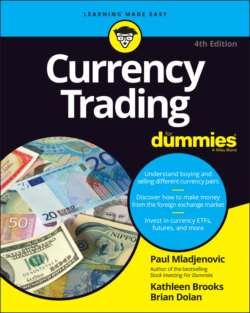Читать книгу Currency Trading For Dummies - Kathleen Brooks - Страница 68
Currency reserve management
ОглавлениеCurrency reserve management refers to how national governments develop and invest their foreign currency reserves. Foreign currency reserves are accumulated through international trade. Countries with large trade surpluses will accumulate reserves of foreign currency over time. Trade surpluses arise when a nation exports more than it imports. Because it is receiving more foreign currency for its exports than it is spending to buy imports, foreign currency balances accumulate. China, one of the world’s largest exporters, has many trillions of dollars as reserves.
The USD has historically been the primary currency for international reserve holdings of most countries. International Monetary Fund (IMF) data from December 2020 showed that the USD accounted for just over 59 percent of global currency reserve holdings, with EUR (20 percent) and remaining currencies (such as the Japanese yen, British pound, and so on) all under 10 percent. You can see more currency data at the IMF’s site at https://data.imf.org.
In recent years, however, the United States has run up massive trade and current account deficits with the rest of the world. The flip side has been the accumulation of large trade surpluses in other countries, most clearly in Asia. The U.S. deficits essentially amount to the United States borrowing money from the countries with trade surpluses, while those other countries (think China) buy IOUs in the form of U.S. Treasury debt securities.
The problem is one of perception and also of prudent portfolio management:
The perception problem stems from the continuing growth of U.S. deficits, which equates to your continually borrowing money from a bank. At a certain point, no matter how good your credit is, the bank will stop lending you money because you’ve already borrowed so much in the first place. In the case of the United States, no one is sure exactly where that point is, but let’s just say we don’t want to find out. In recent years, the U.S. Congress has had to raise its debt ceiling to accommodate its growing need to borrow. At the time of writing, the U.S. debt ceiling stood at more than $28.5 trillion.
The portfolio-management problem arises from the need to diversify assets in the name of prudence. Due to the high proportion of U.S. dollars in global forex reserves, forex reserve managers need to be cognizant of the risks they face if there is a sharp drop in the U.S. dollar’s value. This was particularly relevant after the financial crisis when the U.S. dollar started to weaken.
The result has been an effort by many national governments to begin to diversify their reserves away from the USD and into other major currencies. The euro, the Japanese yen, the British pound, and to a lesser extent the Australian dollar have been the principal beneficiaries of this shift. But before you think the sky is falling, the USD remains the primary reserve currency globally.
In terms of daily forex market trading, national governments (or their operatives) have become regular market participants over the last few years. Generally speaking, they appear to be engaging in active currency reserve management, selling USD on rallies, and buying EUR on weakness. But they’re also not averse to then selling EUR on subsequent strength and buying USD back on weakness.
Currency reserve management has taken on a market prominence in recent years that never existed before. Market talk of central bank buying or selling for reserve management purposes has become almost a daily occurrence. The impact of this in the market varies, but it can frequently lead to multiday highs and lows being maintained in the face of an otherwise compelling trend.
Traders need to closely follow real-time market commentaries for signs of central bank involvement.
